Amaranth
| Amaranthus | |
|---|---|
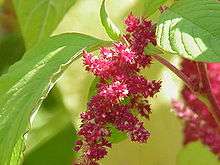 | |
| A. tricolor | |
| Scientific classification | |
| Kingdom: | Plantae |
| (unranked): | Angiosperms |
| (unranked): | Eudicots |
| (unranked): | Core eudicots |
| Order: | Caryophyllales |
| Family: | Amaranthaceae |
| Subfamily: | Amaranthoideae |
| Genus: | Amaranthus L. |
| Species | |
|
See text | |
Amaranthus, collectively known as amaranth,[1] is a cosmopolitan genus of annual or short-lived perennial plants. Some amaranth species are cultivated as leaf vegetables, pseudocereals, and ornamental plants. Most of the species from Amaranthus are summer annual weeds and are commonly referred to as pigweed.[2] Catkin-like cymes of densely packed flowers grow in summer or autumn.[3] Approximately 60 species are recognized, with inflorescences and foliage ranging from purple and red to green or gold. Members of this genus share many characteristics and uses with members of the closely related genus Celosia.
"Amaranth" derives from Greek ἀμάραντος[4] (amárantos), "unfading," with the Greek word for "flower," ἄνθος (ánthos), factoring into the word's development as amaranth. The more accurate amarant is an archaic variant.
Taxonomy

Amaranthus shows a wide variety of morphological diversity among and even within certain species. Although the family (Amaranthaceae) is distinctive, the genus has few distinguishing characters among the 70 species included.[5] This complicates taxonomy and Amaranthus has generally been considered among systematists as a "difficult" genus.[6]
Formerly, Sauer (1955) classified the genus into two subgenera, differentiating only between monoecious and dioecious species: Acnida (L.) Aellen ex K.R. Robertson and Amaranthus.[6] Although this classification was widely accepted, further infrageneric classification was (and still is) needed to differentiate this widely diverse group.
Currently, Amaranthus includes three recognized subgenera and 70 species, although species numbers are questionable due to hybridization and species concepts.[7] Infrageneric classification focuses on inflorescence, flower characters and whether a species is monoecious/dioecious, as in the Sauer (1955) suggested classification.[5] A modified infrageneric classification of Amaranthus was published by Mosyakin & Robertson (1996) and includes three subgenera: Acnida, Amaranthus, and Albersia. The taxonomy is further differentiated by sections within each of the subgenera.[8]
Species
Species include:[9]
- Amaranthus acanthochiton – greenstripe
- Amaranthus acutilobus – is a synonym of Amaranthus viridis[9]
- Amaranthus albus – white pigweed, tumble pigweed
- Amaranthus anderssonii
- Amaranthus arenicola – sandhill amaranth
- Amaranthus australis – southern amaranth
- Amaranthus bigelovii – Bigelow's amaranth
- Amaranthus blitoides – mat amaranth, prostrate amaranth, prostrate pigweed
- Amaranthus blitum – purple amaranth
- Amaranthus brownii – Brown's amaranth
- Amaranthus californicus – California amaranth, California pigweed
- Amaranthus cannabinus – tidal-marsh amaranth
- Amaranthus caudatus – love-lies-bleeding, pendant amaranth, tassel flower, quilete
- Amaranthus chihuahuensis – Chihuahuan amaranth
- Amaranthus crassipes – spreading amaranth
- Amaranthus crispus – crispleaf amaranth
- Amaranthus cruentus – purple amaranth, red amaranth, Mexican grain amaranth
- Amaranthus deflexus – large-fruit amaranth
- Amaranthus dubius – spleen amaranth, khada sag
- Amaranthus fimbriatus – fringed amaranth, fringed pigweed
- Amaranthus floridanus – Florida amaranth
- Amaranthus furcatus
- Amaranthus graecizans
- Amaranthus grandiflorus
- Amaranthus greggii – Gregg's amaranth
- Amaranthus hybridus – smooth amaranth, smooth pigweed, red amaranth
- Amaranthus hypochondriacus – Prince-of-Wales feather, prince's feather
- Amaranthus interruptus – Australian amaranth
- Amaranthus minimus
- Amaranthus mitchellii
- Amaranthus muricatus – African amaranth
- Amaranthus obcordatus – Trans-Pecos amaranth
- Amaranthus palmeri – Palmer's amaranth, Palmer pigweed, careless weed
- Amaranthus polygonoides – tropical amaranth
- Amaranthus powellii – green amaranth, Powell amaranth, Powell pigweed
- Amaranthus pringlei – Pringle's amaranth
- Amaranthus pumilus – seaside amaranth
- Amaranthus retroflexus – red-root amaranth, redroot pigweed, common amaranth
- Amaranthus scleranthoides – variously Amaranthus sclerantoides
- Amaranthus scleropoides – bone-bract amaranth
- Amaranthus spinosus – spiny amaranth, prickly amaranth, thorny amaranth
- Amaranthus standleyanus
- Amaranthus thunbergii – Thunberg's amaranth
- Amaranthus torreyi – Torrey's amaranth
- Amaranthus tricolor – Joseph's-coat
- Amaranthus tuberculatus – rough-fruit amaranth, tall waterhemp
- Amaranthus viridis – slender amaranth, green amaranth
- Amaranthus watsonii – Watson's amaranth
- Amaranthus wrightii – Wright's amaranth
Nutrition
| Nutritional value per 100 g (3.5 oz) | |
|---|---|
| Energy | 1,554 kJ (371 kcal) |
|
65.25 g | |
| Starch | 57.27 g |
| Sugars | 1.69 g |
| Dietary fiber | 6.7 g |
|
7.02 g | |
| Saturated | 1.459 g |
| Monounsaturated | 1.685 g |
| Polyunsaturated | 2.778 g |
|
13.56 g | |
| Tryptophan | 0.181 g |
| Threonine | 0.558 g |
| Isoleucine | 0.582 g |
| Leucine | 0.879 g |
| Lysine | 0.747 g |
| Methionine | 0.226 g |
| Cystine | 0.191 g |
| Phenylalanine | 0.542 g |
| Tyrosine | 0.329 g |
| Valine | 0.679 g |
| Arginine | 1.060 g |
| Histidine | 0.389 g |
| Alanine | 0.799 g |
| Aspartic acid | 1.261 g |
| Glutamic acid | 2.259 g |
| Glycine | 1.636 g |
| Proline | 0.698 g |
| Serine | 1.148 g |
| Vitamins | |
| Thiamine (B1) |
(10%) 0.116 mg |
| Riboflavin (B2) |
(17%) 0.2 mg |
| Niacin (B3) |
(6%) 0.923 mg |
| Pantothenic acid (B5) |
(29%) 1.457 mg |
| Vitamin B6 |
(45%) 0.591 mg |
| Folate (B9) |
(21%) 82 μg |
| Vitamin C |
(5%) 4.2 mg |
| Vitamin E |
(8%) 1.19 mg |
| Minerals | |
| Calcium |
(16%) 159 mg |
| Iron |
(59%) 7.61 mg |
| Magnesium |
(70%) 248 mg |
| Manganese |
(159%) 3.333 mg |
| Phosphorus |
(80%) 557 mg |
| Potassium |
(11%) 508 mg |
| Sodium |
(0%) 4 mg |
| Zinc |
(30%) 2.87 mg |
| Other constituents | |
| water | 11.13 g |
|
| |
| |
|
Percentages are roughly approximated using US recommendations for adults. Source: USDA Nutrient Database | |
1 cup (2.4dl, 245g) of cooked amaranth grain (from approx. 65g raw) provides 251 calories and is an excellent source (20% or more of the Daily Value, DV) of protein, dietary fiber, and some dietary minerals. Amaranth is particularly rich in manganese (105% DV), magnesium (40% DV), iron (29% DV), and selenium (20% DV).[10]
Cooked amaranth leaves are an excellent source of vitamin A, vitamin C, calcium, manganese and folate.[11]
Amaranth does not contain gluten,[12][13][14] so it may be a healthy and less expensive alternative to ingredients traditionally used in gluten-free products.[13] Amaranth has high biological value[12] and its benefits are not limited to people with gluten-related disorders, but are applicable to the general population.[15] Quantity and quality of proteins of amaranth are superior to that of wheat.[13] It also contains higher concentrations of folic acid with respect to wheat (102 µg/100 g in amaranth vs. 40 µg/100 g in wheat), and its fiber and minerals content are higher to those of other cereals.[13]
Amaranth contains phytochemicals that may be anti-nutrient factors, such as polyphenols, saponins, tannins and oxalates which are reduced in content and effect by cooking.[16][17]
Human uses
History
Known to the Aztecs as huauhtli,[18] it is thought to have represented up to 80% of their caloric consumption before the Spanish conquest. Another important use of amaranth throughout Mesoamerica was to prepare ritual drinks and foods. To this day, amaranth grains are toasted much like popcorn and mixed with honey, molasses or chocolate to make a treat called alegría, meaning "joy" in Spanish. Diego Durán described the festivities for Huitzilopochtli, the name of which means "hummingbird of the left side" or "left-handed hummingbird" (Real hummingbirds feed on amaranth flowers). The Aztec month of Panquetzaliztli (7 December to 26 December) was dedicated to Huitzilopochtli. People decorated their homes and trees with paper flags; there were ritual races, processions, dances, songs, prayers, and finally human sacrifices. This was one of the more important Aztec festivals, and the people prepared for the whole month. They fasted or ate very little; a statue of the god was made out of amaranth seeds and honey, and at the end of the month, it was cut into small pieces so everybody could eat a little piece of the god. After the Spanish conquest, cultivation of amaranth was outlawed, while some of the festivities were subsumed into the Christmas celebration.
Because of its importance as a symbol of indigenous culture, its gluten-free palatability, ease of cooking, and a protein that is particularly well-suited to human nutritional needs, interest in grain amaranth (especially A. cruentus and A. hypochondriacus) revived in the 1970s. It was recovered in Mexico from wild varieties and is now commercially cultivated. It is a popular snack sold in Mexico, sometimes mixed with chocolate or puffed rice, and its use has spread to Europe and parts of North America. Amaranth and quinoa are non-grasses and are called pseudocereals because of their similarities to cereals in flavor and cooking.
Seed
Several species are raised for amaranth "grain" in Asia and the Americas.
Ancient amaranth grains still used to this day include the three species, Amaranthus caudatus, Amaranthus cruentus, and Amaranthus hypochondriacus.[19] Although amaranth was cultivated on a large scale in ancient Mexico, Guatemala, and Peru, nowadays it is only cultivated on a small scale there, along with India, China, Nepal, and other tropical countries; thus, there is potential for further cultivation in those countries, as well as in the U.S. In a 1977 article in Science, amaranth was described as "the crop of the future."[20] It has been proposed as an inexpensive native crop that could be cultivated by indigenous people in rural areas for several reasons:
- It is easily harvested.
- Its raw seeds are a good source of protein.[21][22]
- In cooked and edible forms, amaranth retains adequate content of several dietary minerals.[23]
- It is easy to cook.
- As befits its weedy life history, amaranth grains grow rapidly and, in three cultivated species of amaranth, their large seedheads can weigh up to 1 kilogram and contain a half-million small seeds.[22]
Seed flour
Amaranth seed flour has been evaluated as an additive to wheat flour by food specialists. To determine palatability, different levels of amaranth grain flour were mixed with the wheat flour and baking ingredients (1% salt, 2.5% fat, 1.5% yeast, 10% sugar and 52–74% water), fermented, molded, pan-proofed and baked. The baked products were evaluated for loaf volume, moisture content, color, odor, taste and texture. The amaranth containing products were then compared with bread made from 100% wheat flour. The loaf volume decreased by 40% and the moisture content increased from 22 to 42% with increase in amaranth grain flour. The study found that the sensory scores of the taste, odor, color, and texture decreased with increasing amounts of amaranth. Generally, above 15% amaranth grain flour, there were significant differences in the evaluated sensory qualities and the high amaranth-containing product was found to be of unacceptable palatability to the population sample that evaluated the baked products.[24]
Leaves, roots, and stems
Amaranth species are cultivated and consumed as a leaf vegetable in many parts of the world. Four species of Amaranthus are documented as cultivated vegetables in eastern Asia: Amaranthus cruentus, Amaranthus blitum, Amaranthus dubius, and Amaranthus tricolor.[25]
In Indonesia and Malaysia, leaf amaranth is called bayam. In the Philippines, the Ilocano word for the plant is "kalunay"; the Tagalog word for the plant is kilitis or kulitis. In the state of Uttar Pradesh and Bihar in India, it is called chaulai and is a popular green leafy vegetable (referred to in the class of vegetable preparations called saag). It is called chua in Kumaun area of Uttarakhand, where it is a popular red-green vegetable. In Karnataka state in India, it is called harive. It is used to prepare curries like hulee, palya, majjigay-hulee, and so on. In the state of Kerala, it is called cheera and is consumed by stir-frying the leaves with spices and red chillies to make cheera thoran. In Tamil Nadu, it is called mulaikkira and is regularly consumed as a favourite dish, where the greens are steamed, and mashed, with light seasoning of salt, red chili, and cumin. It is called keerai masial. In Andhra Pradesh, this leaf is added in preparation of a popular dal called thotakura pappu in (Telugu). In Maharashtra, it is called shravani maath and is available in both red and white colour. In Orissa, it is called khada saga, it is used to prepare saga bhaja, in which the leaf is fried with chili and onions.
In China, the leaves and stems are used as a stir-fry vegetable, or in soups. In Vietnam, it is called rau dền and is used to make soup. Two species are popular as edible vegetable in Vietnam: dền đỏ- Amaranthus tricolor and dền cơm or dền trắng- Amaranthus viridis.
A traditional food plant in Africa, amaranth has the potential to improve nutrition, boost food security, foster rural development and support sustainable land care.[26]
In Bantu regions of Uganda and Western Kenya, it is known as doodo or litoto.[27] It is also known among the Kalenjin as a drought crop (chepkerta). In Lingala (spoken in the Congo), it is known as lɛngalɛnga or bítɛkutɛku.[28] In Nigeria, it is a common vegetable and goes with all Nigerian starch dishes. It is known in Yoruba as shoko a short form of shokoyokoto (meaning make the husband fat) or arowo jeja (meaning "we have money left over for fish"). In the Caribbean, the leaves are called bhaji in Trinidad and callaloo in Jamaica, and are sautéed with onions, garlic, and tomatoes, or sometimes used in a soup called pepperpot soup. In Botswana, it is referred to as morug and cooked as a staple green vegetable.
In Greece, green amaranth (A. viridis) is a popular dish called βλήτα, vlita or vleeta. It is boiled, then served with olive oil and lemon juice like a salad, sometimes alongside fried fish. Greeks stop harvesting the plant (which also grows wild) when it starts to bloom at the end of August.
In Brazil, green amaranth was, and to a degree still is, frequently regarded as an invasive species as all other species of amaranth (except the generally imported A. caudatus cultivar), though some have traditionally appreciated it as a leaf vegetable, under the names of caruru or bredo, which is consumed cooked, generally accompanying the staple food, rice and beans.
Dyes
The flowers of the 'Hopi Red Dye' amaranth were used by the Hopi (a tribe in the western United States) as the source of a deep red dye. Also a synthetic dye was named "amaranth" for its similarity in color to the natural amaranth pigments known as betalains. This synthetic dye is also known as Red No. 2 in North America and E123 in the European Union.[29]
Ornamentals
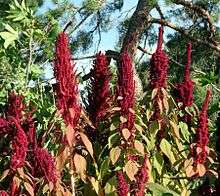
The genus also contains several well-known ornamental plants, such as Amaranthus caudatus (love-lies-bleeding), a vigorous, hardy annual with dark purplish flowers crowded in handsome drooping spikes. Another Indian annual, A. hypochondriacus (prince's feather), has deeply veined lance-shaped leaves, purple on the under face, and deep crimson flowers densely packed on erect spikes.
Amaranths are recorded as food plants for some Lepidoptera (butterfly and moth) species including the nutmeg moth and various case-bearer moths of the genus Coleophora: C. amaranthella, C. enchorda (feeds exclusively on Amaranthus), C. immortalis (feeds exclusively on Amaranthus), C. lineapulvella and C. versurella (recorded on A. spinosus).
Ecology
Amaranth weed species have an extended period of germination, rapid growth, and high rates of seed production,[2] and have been causing problems for farmers since the mid-1990s. This is partially due to the reduction in tillage, reduction in herbicidal use and the evolution of herbicidal resistance in several species where herbicides have been applied more often.[30] The following 9 species of Amaranthus are considered invasive and noxious weeds in the U.S and Canada: A. albus, A. blitoides, A. hybridus, A. palmeri, A. powellii, A. retroflexus, A. spinosus, A. tuberculatus, and A. viridis.[31]
A new herbicide-resistant strain of Amaranthus palmeri has appeared; it is glyphosate-resistant and so cannot be killed by herbicides using the chemical. Also, this plant can survive in tough conditions. This could be of particular concern to cotton farmers using glyphosate-resistant cotton.[32] The species Amaranthus palmeri (Palmer amaranth) causes the greatest reduction in soybean yields and has the potential to reduce yields by 17-68% in field experiments.[2] Palmer amaranth is among the "top five most troublesome weeds" in the southeast of the United States and has already evolved resistances to dinitroaniline herbicides and acetolactate synthase inhibitors.[33] This makes the proper identification of Amaranthus species at the seedling stage essential for agriculturalists. Proper weed control needs to be applied before the species successfully colonizes in the crop field and causes significant yield reductions.
Myth, legend and poetry
The word amaranth comes from the Greek word amaranton, meaning "unwilting" (from the verb marainesthai meaning "wilt").[34] The word was applied to amaranth because it did not soon fade and so symbolized immortality. "Amarant" is a more correct, albeit archaic form, chiefly used in poetry. The current spelling, amaranth, seems to have come from folk etymology that assumed the final syllable derived from the Greek word anthos ("flower"), common in botanical names.
An early Greek fable counted among Aesop's Fables compares the rose to the amaranth to illustrate the difference in fleeting and everlasting beauty:
An amaranth planted in a garden near a Rose-Tree, thus addressed it: "What a lovely flower is the Rose, a favourite alike with Gods and with men. I envy you your beauty and your perfume." The Rose replied, "I indeed, dear Amaranth, flourish but for a brief season! If no cruel hand pluck me from my stem, yet I must perish by an early doom. But thou art immortal and dost never fade, but bloomest for ever in renewed youth."[35]
John Milton's epic Paradise Lost gives amaranth an illustrious neighbour:
Immortal amaranth, a flower which once
In paradise, fast by the tree of life,
Began to bloom; but soon for man's offence
To heaven removed, where first it grew, there grows,
And flowers aloft, shading the fount of life,
And where the river of bliss through midst of heaven
Rolls o'er elysian flowers her amber stream:
With these that never fade the spirits elect
Bind their resplendent locks.
Samuel Taylor Coleridge, in Work Without Hope (1825), also refers to the herb, likely referencing Milton's earlier work. (ll 7-10 excerpted):
Yet well I ken the banks where Amaranths blow,
Have traced the fount whence streams of nectar flow.
Bloom, O ye Amaranths! bloom for whom ye may,
For me ye bloom not! Glide, rich streams, away!
Percy Bysshe Shelley refers to the herb in his poem "Bereavement" (Lines 13-16 excerpted):
Eternity points, in its amaranth bower
Where no clouds of fate o'er the sweet prospect lour,
Unspeakable pleasure, of goodness the dower,
When woe fades away like the mist of the heath.
In his dialogue "Aesop and Rhodopè", published in 1844, Walter Savage Landor wrote:
There are no fields of amaranth on this side of the grave:
there are no voices, O Rhodopè, that are not soon mute, however tuneful:
there is no name, with whatever emphasis of passionate love repeated,
of which the echo is not faint at last.
Joachim du Bellay mentioned the herb in his "A Vow To Heavenly Venus," ca. 1500:
We that with like hearts love, we lovers twain,
New wedded in the village by thy fane,
Lady of all chaste love, to thee it is
We bring these amaranths, these white lilies,
A sign, and sacrifice; may Love, we pray,
Like amaranthine flowers, feel no decay;
Like these cool lilies may our loves remain,
Perfect and pure, and know not any stain;
And be our hearts, from this thy holy hour,
Bound each to each, like flower to wedded flower.
In the fourth book[37] of Endymion (1818), John Keats writes:
The spirit culls
Unfaded amaranth, when wild it strays
Through the old garden-ground of boyish days.
In ancient Greece, the amaranth (also called chrysanthemum and helichrysum) was sacred to Ephesian Artemis. It allegedly had special healing properties, and, as a symbol of immortality, was used to decorate images of the gods and tombs. In legend, Amarynthus (a form of "Amarantus") was a hunter of Artemis and king of Euboea; in a village of Amarynthus, of which he was the eponymous hero, there was a famous temple of Artemis Amarynthia or Amarysia (Strabo x. 448; Pausan. i. 31, p. 5). The Chinese used amaranth widely for its healing chemicals, treating illnesses such as infections, rashes, and migraines. "Amarantos" is the name of a several-centuries-old popular Greek folk-song:
Look at the amaranth:
on tall mountains it grows,
on the very stones and rocks
and places inaccessible.
In the poem "The Hound of Heaven" (1893), Francis Thompson compares God's love to "an amaranthine weed..."
Ah! is Thy love indeed
A weed, albeit an amaranthine weed,
Suffering no flowers except its own to mount?[1]
- ^ "The Hound of Heaven". elcore.net.
The Swedish metal band Amaranthe is named for the plant.
Images
-

Love-lies-bleeding (Amaranthus caudatus)
-
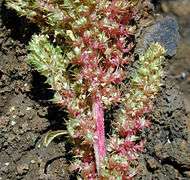
Green Amaranth (A. hybridus)
-
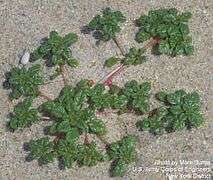
Seabeach amaranth (A. pumilus), an amaranth on the Federal Threatened species List
-

Red-root Amaranth (A. retroflexus) - from Thomé, Flora von Deutschland, Österreich und der Schweiz 1885
-
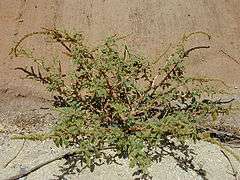
Spiny Amaranth (Amaranthus spinosus)
-

Green Amaranth (Amaranthus viridis)
-

Popping Amaranth (Amaranthus sp.)
-
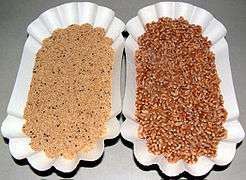
Amaranth grain (left) and wheat (right)
-
Southern Kerala-style traditional Thoran made with Cheera (Amaranth) leaves
-
.jpg)
Example from Chilpancingo
See also
References
- ↑ "Amaranthaceae | plant family". Retrieved 2015-06-02.
- 1 2 3 Bensch et al. (2003). Interference of redroot pigweed (Amaranthus retroflexus), Palmer amaranth (A. palmeri), and common waterhemp (A. rudis) in soybean. Weed Science 51: 37-43.
- ↑ RHS A-Z encyclopedia of garden plants. United Kingdom: Dorling Kindersley. 2008. p. 1136. ISBN 1405332964.
- ↑ ἀμάραντος. Liddell, Henry George; Scott, Robert; A Greek–English Lexicon at the Perseus Project
- 1 2 Juan; et al. (2007). "Electrophoretic characterization of Amaranthus L. seed proteins and its systematic implication". Botanical Journal of the Linnean Society. 155: 57–63. doi:10.1111/j.1095-8339.2007.00665.x.
- 1 2 Costea M, DeMason D (2001). "Stem morphology and anatomy in Amaranthus L. (Amaranthaceae)- Taxonomic significance". Journal of the Torrey Botanical Society. 128 (3): 254–281. doi:10.2307/3088717. JSTOR 3088717.
- ↑ Judd et al. (2008). Plant Systematics: A Phylogenetic Approach, Third Edition. Sinauer Associates, Inc. Sunderland, MA
- ↑ Mosyakin & Robertson (1996). "New infrageneric taxa and combinations in Amaranthus (Amaranthaceae)". Ann. Bot. Fennici. 33: 275–281.
- 1 2 "Search results — The Plant List". theplantlist.org.
- ↑ "Amaranth grain, cooked". USDA National Nutrient Database, release SR-28. 2015. Retrieved 4 February 2016.
- ↑ "Amaranth leaves, cooked, boiled, drained, without salt, per 100 g". Conde Nast for the USDA National Nutrient Database, release SR-21. 2015. Retrieved 4 February 2016.
- 1 2 Lamacchia C, Camarca A, Picascia S, Di Luccia A, Gianfrani C (Jan 29, 2014). "Cereal-based gluten-free food: how to reconcile nutritional and technological properties of wheat proteins with safety for celiac disease patients". Nutrients (Review). 6 (2): 575–90. doi:10.3390/nu6020575. PMC 3942718
 . PMID 24481131.
. PMID 24481131. - 1 2 3 4 Penagini F, Dilillo D, Meneghin F, Mameli C, Fabiano V, Zuccotti GV (Nov 18, 2013). "Gluten-free diet in children: an approach to a nutritionally adequate and balanced diet". Nutrients (Review). 5 (11): 4553–65. doi:10.3390/nu5114553. PMC 3847748
 . PMID 24253052.
. PMID 24253052. - ↑ Gallagher, E.; T. R. Gormley; E. K. Arendt. "Recent advances in the formulation of gluten-free cereal-based products" (PDF). Trends in Food Science & Technology (Review). 15 (3-4): 143–152. doi:10.1016/j.tifs.2003.09.012.
- ↑ Rahaie S, Gharibzahedi SM, Razavi SH, Jafari SM (2014). "Recent developments on new formulations based on nutrient-dense ingredients for the production of healthy-functional bread: a review". J Food Sci Technol (Review). 51 (11): 2896–906. doi:10.1007/s13197-012-0833-6. PMC 4571229
 . PMID 26396285.
. PMID 26396285. - ↑ "Legacy - The Official Newsletter of Amaranth Institute; see pages 6-9" (PDF). Amaranth Institute. 1992.
- ↑ Hotz C, Gibson RS (2007). "Traditional food-processing and preparation practices to enhance the bioavailability of micronutrients in plant-based diets". J Nutr. 137 (4): 1097–100. PMID 17374686.
- ↑ Coe, S.D. (1994). America's First Cuisines. University of Texas Press. ISBN 9780292711594.
- ↑ Costea et al. (2006). Delimitation of A. cruentus L. and A. caudatus L. using micromorphology and AFLP analysis: an application in germplasm identification. Genetic Resources and Crop Evolution 53: 1625-1633.
- ↑ Marx (1977). Speaking of Science: Amaranth: A Comeback for the Food of the Aztecs? Science 198(4312): 40.
- ↑ De Macvean & Pöll (1997). Chapter 8: Ethnobotany. Tropical Tree Seed Manual, USDA Forest Service, edt. J.A Vozzo.
- 1 2 Tucker, J. (1986). Amaranth: the once and future crop. Bioscience 36(1): 9-13.
- ↑ "USDA National Nutrient Database: cooked amaranth grain per 100 grams; Full report". 2014. Retrieved 30 November 2015.
- ↑ Jerome Ayo (2001). "THE EFFECT OF AMARANTH GRAIN FLOUR ON THE QUALITY OF BREAD". International Journal of Food Properties. 4 (2): 341. doi:10.1081/JFP-100105198.
- ↑ Costea (2003). Notes on Economic Plants. Economic Botany 57(4): 646-649
- ↑ National Research Council (2006-10-27). "Amaranth". Lost Crops of Africa: Volume II: Vegetables. Lost Crops of Africa. 2. National Academies Press. ISBN 978-0-309-10333-6. OCLC 34344933. Retrieved 2008-07-15.
- ↑ Goode, P. M. (1989). Edible plants of Uganda. Food and Agriculture Organization of the United Nations. pp. 25–6. ISBN 9789251027134.
- ↑ Enama, M. (1994). "Culture: The missing nexus in ecological economics perspective". Ecological Economics. 10 (10): 93–95. doi:10.1016/0921-8009(94)00010-7.
- ↑ "The following color additives are not authorized for use in food products in the United States: (1) Amaranth (C.I. 16185, EEC No. E123, formerly certifiable as FD&C red No. 2);" FDA/CFSAN Food Compliance Program: Domestic Food Safety Program
- ↑ Wetzel et al. (1999). Use of PCR-based molecular markers to identify weedy Amaranthus species. Weed Science 47: 518-523.
- ↑ USDA Plant Database. Plants Profile- Amaranthus L
- ↑ "Herbicide Resistant Weeds Causing Problems for US Cotton Growers". organicconsumers.org.
- ↑ Culpepper et al. (2006). Glyphosate-resistant Palmer amaranth (Amaranthus palmeri) confirmed in Georgia. Weed Science 54: 620-626.
- ↑ Nagy, Gregory (2013). The Ancient Greek Hero in 24 Hours. Cambridge, MA, USA: Harvard University Press. p. 14§32. ISBN 978-0674073401.
Technically, the blossoms that form the circles of these garlands come from the name of a flower known as amaranton or 'amaranth', which literally means 'unwilting' (from the verb marainesthai, meaning 'wilt'). The blossoms of the flower amaranth that are plaited into garlands mimic eternity, since the blossom of the amaranth is observably slow in wilting, unlike the blossoms of most flowers.
- ↑ "THE ROSE AND THE AMARANTH". mythfolklore.net.
- ↑ Milton, John. Paradise Lost. III. 353.
- ↑ "Endymion_Book IV".
Additional reading
- Howard, Brian Clark. "Amaranth: Another Ancient Wonder Food, But Who Will Eat It?". National Geographic Online, August 12, 2013.
- Lenz, Botanik der alt. Greich. und Rom. Botany of old. (1859)
- J. Murr, Die Pflanzenwelt in der griech. Mythol. Plants in Greek Mythology. (1890)
- Fanton M., Fanton J. Amaranth The Seed Savers' Handbook. (1993)
External links
| Wikimedia Commons has media related to Amaranthus. |